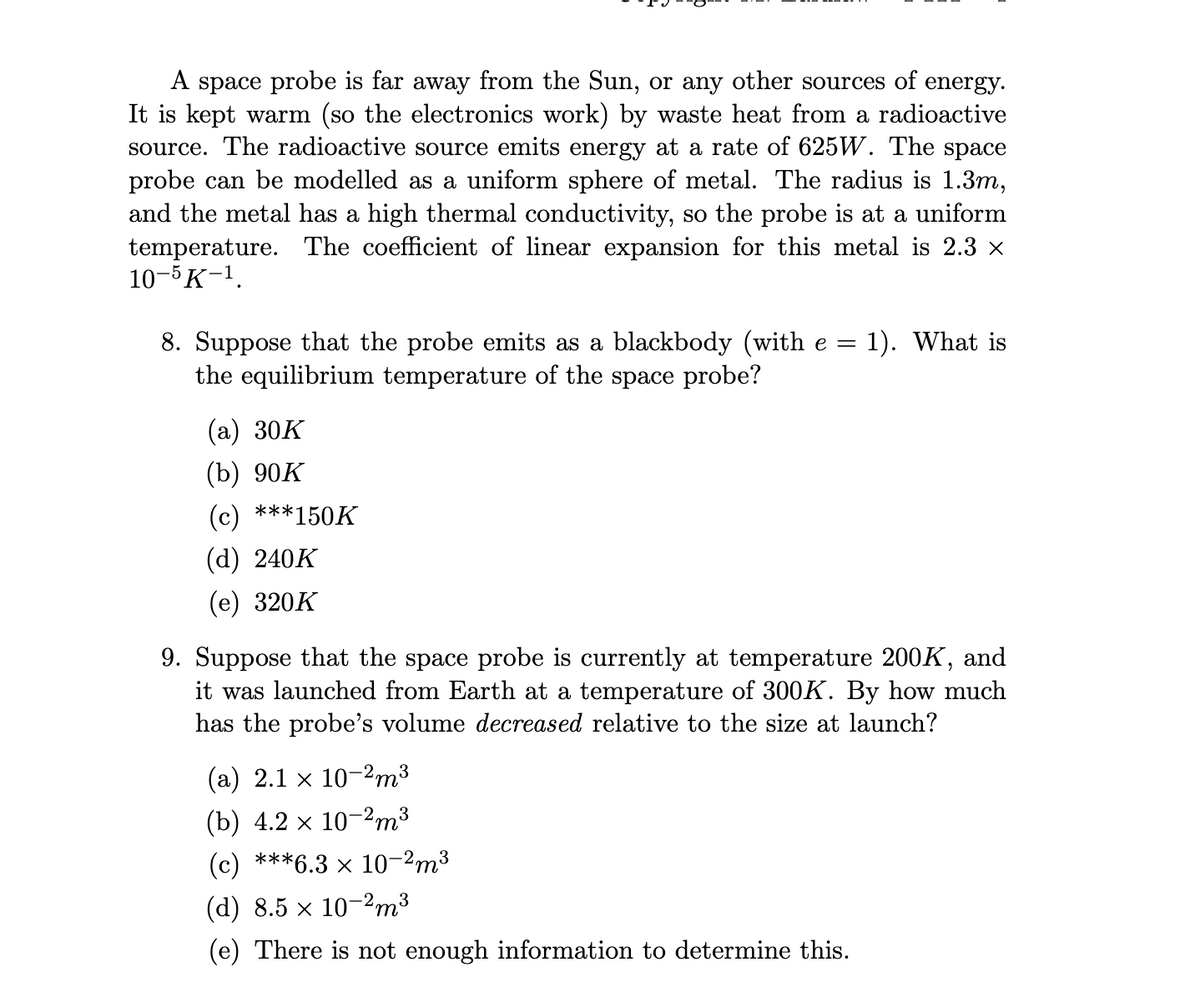A space probe is far away from the Sun, or any other sources of energy. It is kept warm (so the electronics work) by waste heat from a radioactive source. The radioactive source emits energy at a rate of 625W. The space probe can be modelled as a uniform sphere of metal. The radius is 1.3m, and the metal has a high thermal conductivity, so the probe is at a uniform temperature. The coefficient of linear expansion for this metal is 2.3 × 10-5 K-¹. 8. Suppose that the probe emits as a blackbody (with e = 1). What is the equilibrium temperature of the space probe? (a) 30K (b) 90K (c) ***150K (d) 240K (e) 320K 9. Suppose that the space probe is currently at temperature 200K, and it was launched from Earth at a temperature of 300K. By how much has the probe's volume decreased relative to the size at launch? (a) 2.1 x 10-2m³ (b) 4.2 × 10-2m³ (c) ***6.3 × 10-²m³ (d) 8.5 x 10-2m³ (e) There is not enough information to determine this.
A space probe is far away from the Sun, or any other sources of energy. It is kept warm (so the electronics work) by waste heat from a radioactive source. The radioactive source emits energy at a rate of 625W. The space probe can be modelled as a uniform sphere of metal. The radius is 1.3m, and the metal has a high thermal conductivity, so the probe is at a uniform temperature. The coefficient of linear expansion for this metal is 2.3 × 10-5 K-¹. 8. Suppose that the probe emits as a blackbody (with e = 1). What is the equilibrium temperature of the space probe? (a) 30K (b) 90K (c) ***150K (d) 240K (e) 320K 9. Suppose that the space probe is currently at temperature 200K, and it was launched from Earth at a temperature of 300K. By how much has the probe's volume decreased relative to the size at launch? (a) 2.1 x 10-2m³ (b) 4.2 × 10-2m³ (c) ***6.3 × 10-²m³ (d) 8.5 x 10-2m³ (e) There is not enough information to determine this.
College Physics
1st Edition
ISBN:9781938168000
Author:Paul Peter Urone, Roger Hinrichs
Publisher:Paul Peter Urone, Roger Hinrichs
Chapter14: Heat And Heat Transfer Methods
Section: Chapter Questions
Problem 62PE: The Sun radiates like a perfect black body with an emissivity of exactly 1. (a) Calculate the...
Related questions
Question

Transcribed Image Text:A space probe is far away from the Sun, or any other sources of energy.
It is kept warm (so the electronics work) by waste heat from a radioactive
source. The radioactive source emits energy at a rate of 625W. The space
probe can be modelled as a uniform sphere of metal. The radius is 1.3m,
and the metal has a high thermal conductivity, so the probe is at a uniform
temperature. The coefficient of linear expansion for this metal is 2.3 ×
10-5 K-¹.
8. Suppose that the probe emits as a blackbody (with e = 1). What is
the equilibrium temperature of the space probe?
(a) 30K
(b) 90K
(c) ***150K
(d) 240K
(e) 320K
9. Suppose that the space probe is currently at temperature 200K, and
it was launched from Earth at a temperature of 300K. By how much
has the probe's volume decreased relative to the size at launch?
(a) 2.1 x 10-2m³
(b) 4.2 × 10-²m³
(c) ***6.3 × 10-²m³
(d) 8.5 × 10-2m³
(e) There is not enough information to determine this.
Expert Solution
This question has been solved!
Explore an expertly crafted, step-by-step solution for a thorough understanding of key concepts.
Step by step
Solved in 3 steps

Knowledge Booster
Learn more about
Need a deep-dive on the concept behind this application? Look no further. Learn more about this topic, physics and related others by exploring similar questions and additional content below.Recommended textbooks for you

College Physics
Physics
ISBN:
9781938168000
Author:
Paul Peter Urone, Roger Hinrichs
Publisher:
OpenStax College

Principles of Physics: A Calculus-Based Text
Physics
ISBN:
9781133104261
Author:
Raymond A. Serway, John W. Jewett
Publisher:
Cengage Learning

Physics for Scientists and Engineers: Foundations…
Physics
ISBN:
9781133939146
Author:
Katz, Debora M.
Publisher:
Cengage Learning

College Physics
Physics
ISBN:
9781938168000
Author:
Paul Peter Urone, Roger Hinrichs
Publisher:
OpenStax College

Principles of Physics: A Calculus-Based Text
Physics
ISBN:
9781133104261
Author:
Raymond A. Serway, John W. Jewett
Publisher:
Cengage Learning

Physics for Scientists and Engineers: Foundations…
Physics
ISBN:
9781133939146
Author:
Katz, Debora M.
Publisher:
Cengage Learning
